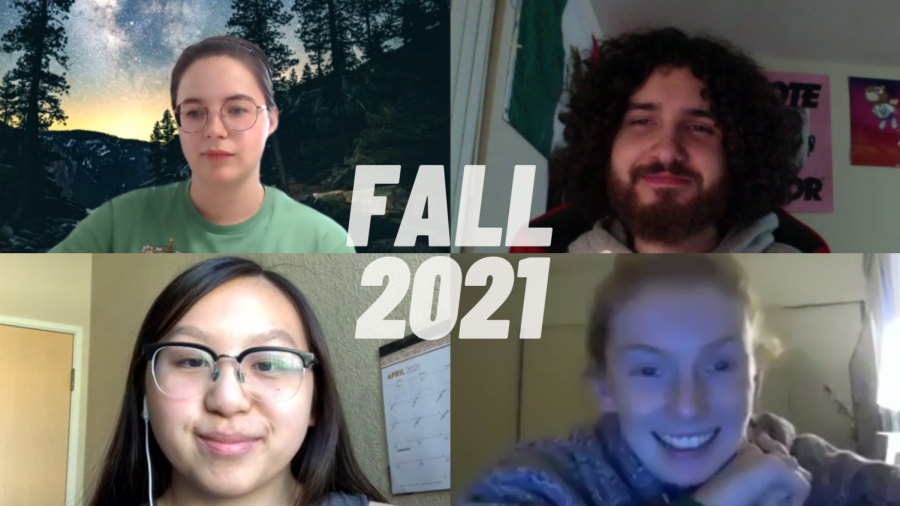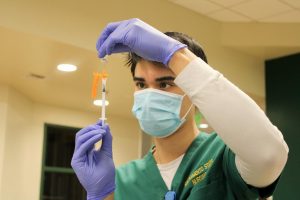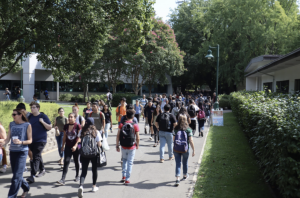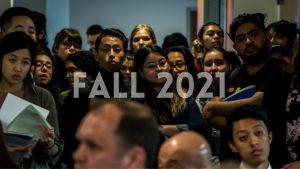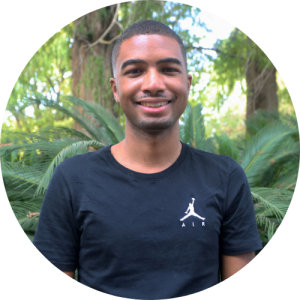‘Excited to go back’: Sac State students weigh in on fall 2021 teaching modalities
Campus survey draws polarized opinions on in-person classes
(Clockwise from top left) Sarah Miller, Robert Wiemer, Erin Wardle and Gao Thao share their thoughts on returning to in-person classes at Sacramento State in fall 2021. Sac State students should expect to take in-person classes in the fall, according to Provost Steve Perez. Photos taken via Zoom by Michael Eskridge.
April 22, 2021
As Sacramento State and the California State University plan to hold 50% of classes in person next fall, the first time a majority of Sac State students will have in-person classes since the beginning of the COVID-19 pandemic, students shared mixed feelings towards returning to campus.
According to a class format preference survey sent by the Office of Institutional Research, Effectiveness, and Planning on March 18, students were polarized in their opinions of returning to in-person classes.
595 students responded to the survey, and respondents were split on whether they would register for most types of in-person classes. The two exceptions to the polarization were in-person lectures with little to no student participation and science or clinical lab activities.
A majority of the responding students said they would be unlikely to register for an in-person lecture with minimal student participation. A majority also said they would be likely to register for in-person science or clinical labs.
The survey results “can be explained by the current polarization in views towards quarantine,” wrote Sac State research technician and author of the survey Erryn Rivers in the survey results summary. She wrote there are “many individuals expressing anxieties towards meeting face-to-face and many other individuals who are ready to resume regular interactions.”
The State Hornet spoke to students to get their feelings about in-person classes as the Sac State community prepares to return to campus.
Anthropology major Brittany Pesch is one student who prefers a face-to-face format for the upcoming semester.
“I personally am excited to go back to campus,” Pesch said. “I hope everyone can get vaccinated by then.”
RELATED: Sac State begins administering COVID-19 vaccines to students on campus
Biology major Gao Thao, 20, also misses in-person classes and thinks Sac State can “slowly transition” back to normalcy with safety regulations and protocols in place.
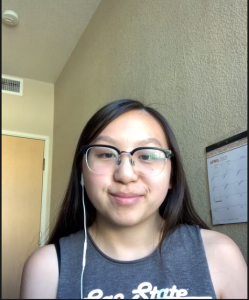
In regards to health and safety concerns, Thao said the biggest concern is regarding vaccinations.
“I highly encourage other students to get vaccinated if they plan on coming back to campus,” Thao said. “Not only are they protecting themselves, but us [students] and the professors.”
The CSU announced Thursday it will require faculty, staff and students who will be accessing campus facilities in fall 2021 to receive the COVID-19 vaccination upon the Food and Drug administration’s approval, according to an email announcement by the CSU on Thursday.
Robert Wiemer, an economics major, said he also has safety concerns about returning to campus.
“I feel like it’s important for everyone to still be wearing their mask, maybe sit a couple of desks apart. Not everyone is comfortable being around other people yet,” Wiemer said.
RELATED: Sac State could hold classes with at least 50% capacity in fall 2021, Provost says
Erin Wardle, a 23-year-old interior design major, is planning to graduate in December 2021 and said she thinks administration is doing a good job at keeping students safe. Wardle also thinks it is important for classes to have both in-person and online options.
“People might be worried about going back to in-person classes and being around many people, even though everyone will still be wearing masks,” Wardle said. “The biggest thing is to make sure the admin takes the right steps to keeping all of the students safe, and making sure that everybody continues to feel comfortable.”

Biology major Sarah Miller, 28, said she is not a fan of online classes and is happy to be returning to in-person instruction.
“I personally have dyslexia so this is not my mode of education that I enjoy the most,” Miller said. “I never opted to take the online classes when they were available even at the community college level. I just really want to be able to see things, touch things.”
RELATED: Proposed fall 2021 class schedules for Sac State now visible on Student Center
Other students have had difficulty scheduling their fall 2021 semester as desired. Katelyn Shea, a senior majoring in English, said most of the classes they need to graduate are online.
“Honestly, as someone going into my senior year, this is a little bit of a slap in the face from what Sac State is promising,” Shea said. “Most of my professors are still terrible at online teaching.”
Shea said students’ decision to return to campus for the fall also depends on how they handled online learning.
“I completely want students to be safe; however, lots of students I know are failing classes, having to cheat to get by, or having large amounts of anxiety and depression, because they feel like failures for not understanding the curriculum,” Shea said.
RELATED: Isolation and grief: Sac State students cope with declining mental health during pandemic
Environmental science major Alex Sánchez said that he is considering taking a gap semester to do an internship in his field rather than do another semester partially online.
“Although I stuck through the year doing online courses, doing a whole other semester online isn’t an appealing option,” Sánchez said via Twitter direct message.
Sánchez said that he feels he is not getting the preparation he needs from online schooling since arriving at Sac State and credits his persistence through online school to what he has learned from previous schools.
“I was not ‘made’ here but rather my previous institution that has equipped me with the necessary tools in order to survive this,” Sánchez said. “Ultimately, the reason for wanting in-person is because I want to feel prepared in my field, and want to graduate feeling so. As of right now, online schooling isn’t offering that assurance.”
Survey draws polarized responses on in-person classes
The survey responses skewed towards students being unlikely to register for hybrid classes.
Responses also showed students were likely to register for online classes of most types but polarized on physical, artistic or performance activities and science or clinical lab activities.
The survey was sent to 7,795 randomly selected Sac State students, and of those, 595 students responded.
Lauren Cappiello, a statistics professor at Sac State, said the low response rate of the survey is a concern. Cappiello also said that the biggest potential source of bias is what she calls “nonresponse bias.”
“Students who do not have strong feelings about teaching modality may have skipped the survey, while students with strong feelings may have been more motivated to give feedback,” Cappiello said via email. “Since we don’t have results from students who chose not to participate, there’s no way to know exactly what the results would look like if everyone had responded.”
Rivers referred to the survey as a “Flash Survey” meant to quickly grab students’ opinions. Rivers said non-responses are typical in surveys like this and that researchers are not always going to get “middle ground” responses.
“Students who are a little more isolated or not as connected with the campus are not going to do surveys like this,” Rivers said. She said these sorts of surveys receive responses from “strong, polarizing opinions.”
Rivers said the survey was not sent to all students because Sac State administration did not want to overload students with survey emails.
The survey will not serve to make any major decisions, Rivers said.
Cappiello said that despite increased likelihood for more responses from students with strong opinions on the subject matter, focusing on these students also has value.
“If a significant number of students prefer online learning, that is important information for us to keep in mind as we move toward fully repopulating campus,” Cappiello said.






























































































































